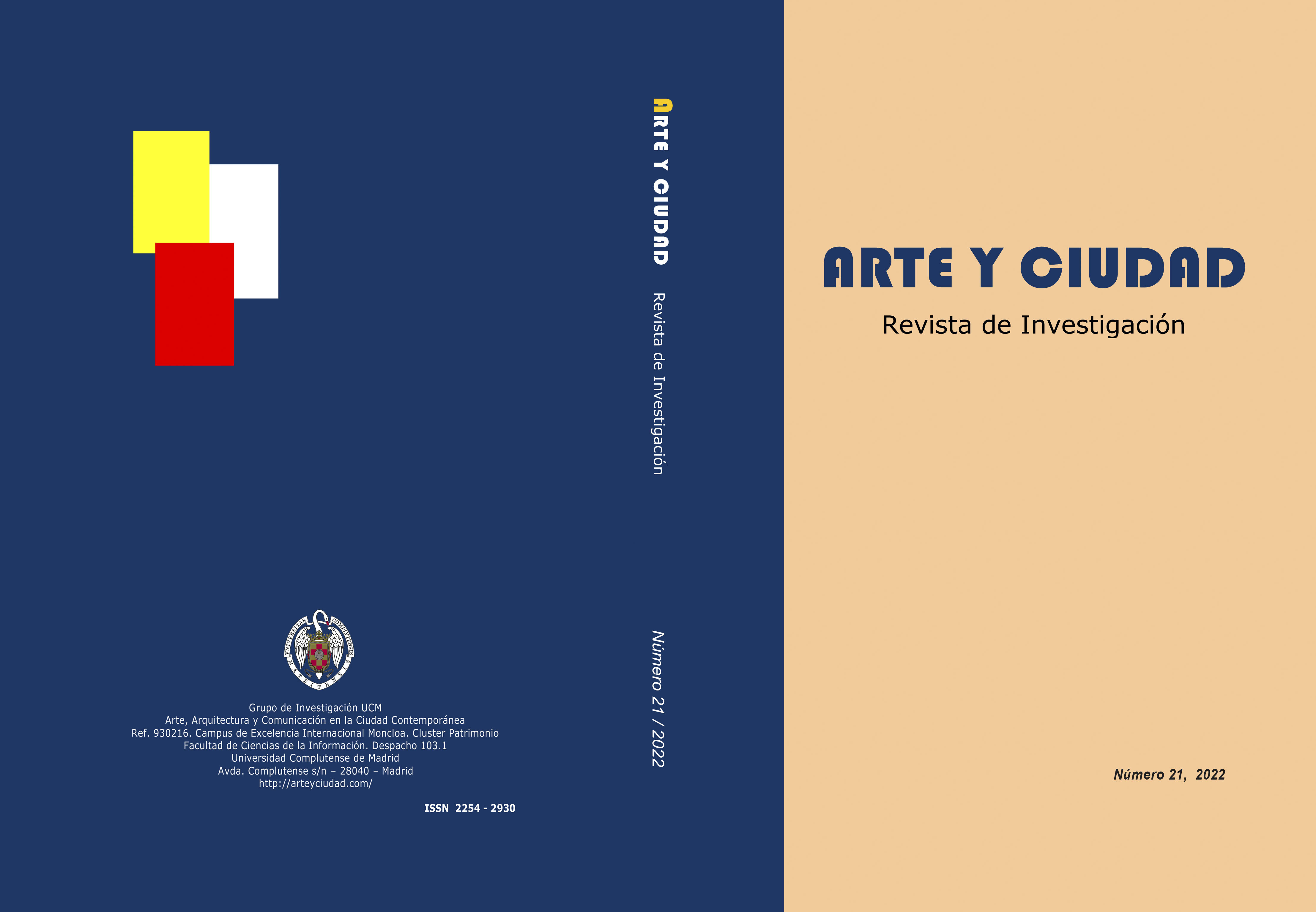La convivencia entre el graffiti y el brutalismo: el arte urbano como paradigma en la arquitectura de la Facultad de Ciencias de la Información de la Universidad Complutense de Madrid
DOI:
https://doi.org/10.22530/ayc.2023.24.722Palabras clave:
Graffiti, brutalismo, arte urbano, Facultad de Ciencias de la Información, coexistencia creativa, innovación artísticaResumen
Este artículo explora la fascinante interacción entre el graffiti y la arquitectura brutalista en la Facultad de Ciencias de la Información de la Universidad Complutense de Madrid. Comienza destacando la importancia de analizar esta relación única y utiliza una metodología que combina investigación documental y observación in situ para explorar los murales y graffitis en la facultad. Se analizan aspectos clave, como la historia del graffiti y la imponente arquitectura brutalista, destacando su influencia emocional y visual. El estudio examina el impacto de esta relación en la comunidad universitaria y resalta cómo el graffiti desafía las apariencias y enriquece el entorno. Concluye que esta simbiosis crea un espacio de innovación artística y permite una expresión legítima de la creatividad, subrayando su importancia para el futuro del graffiti y la arquitectura brutalista en el entorno académico y artístico. El artículo celebra esta coexistencia creativa en la Facultad.
Citas
AAVEDRA, F. F. I. (2007). El graffiti en metálico: análisis sobre el graffiti y la circulación monetaria. Revista Historia y Comunicación Social, 12, 23–44.
ARNHEIM, R. (1986). Hacia una psicología del arte. Arte y entropía. Madrid: Alianza Forma.
BASTIDAS BOLAÑOS, David Antonio. (2023). Hacia un brutalismo de lo su-blime. Violencia y poder en la Analítica de lo sublime de la Crítica de la facultad de juzgar. Estudios de Filosofía, (67), 89-110. Epub January 24, 2023. https://doi.org/10.17533/udea.ef.349343
BATAILLE, G. (2010). El erotismo. Buenos Aires: Tusquets.
BERMÚDEZ, J., & NAVARRETE, S. (2019). La dimensión espiritual de la materia arquitectónica. Reflexiones fenomenológicas sobre el brutalismo. MÓDULO ARQUITECTURA CUC, 23(1), 89–120.
https://doi.org/10.17981/mod.arq.cuc.23.1.2019.05
CASTLEMAN, C. (1987). Los Graffiti. Barcelona: Herman Blume. [Getting Up: Subway Graffiti in New York, 1982. Cambridge: MIT Press].
COUVREUX ALIJARTE. N. A. (2017). Visión purista y visión evolutiva: Dos maneras de concebir el graffiti y el arte urbano. Tercio Creciente, 11, págs.131-150. DOI: 10.17561/rtc.n11.9
DANIELL, C., CLOSE, S. J. & FARM, B. (2011). Graffiti, Calliglyphs and Mark-ers in the UK. Archaeologies: Journal of the World Archaeological Congress, 7(2), 454–476. https://doi.org/10.1007/s11759-011-9176-6
DE DIEGO RUIZ, P. (2017). Brutalismos educativos: La arquitectura como nueva psicogeografía social. N17 Arquitectura Escolar y Educación, Uni-versidad de Sevilla, 2171–6897 / 2173–1616. http://dx.doi.org/10.12795/ppa2017i17.06
DELEUZE, G. y GUATTARI, F. (1977). Rizoma. Introducción. Valencia: Pre-Textos.
FORTOUL VAN DER GOES, Teresa I. (2020). Seré famoso algún día. Revista de la Facultad de Medicina (México), 63(3), 57-58. Epub 05 de marzo de 2021. https://www.medigraphic.com/pdfs/facmed/un-2020/un203i.pdf
FREDERICK, U. K. (2009). Revolution is the New Black: Graffiti / Art and Mark-making Practices. Archaeologies: Journal of the World Archaeological Congress, 5(2), 210–237. https://doi.org/10.1007/s11759-009-9107-y
GARCÍA, D. J. (2016). Rara Avis. Una teoría queer impolítica. Madrid: Melusi-na.
GARÍ, J. (1995). La conversación mural. Ensayo para una lectura del graffiti. Madrid. Fundesco.
LANGENSCHEIDT. (2018). Langenscheidt diccionario universal alemán: español - alemán / alemán-español. Langenscheidt Verlag.
LUQUE RODRIGO, L. (2019). Identidad e imagen de la ciudad contemporánea: los museos de arte urbano. Ge-Conservación, 16, 176-185. Recuperado de https://ge-iic.com/ojs/index.php/revista/article/view/706/919
LUQUE RODRIGO, L.; MORAL RUIZ, C. (2021). El arte urbano como patrimonio inmaterial. Posibilidades para su protección y difusión. En I Simposio anual de Patrimonio Natural y Cultural ICOMOS España. Editorial Univer-sitat Politècnica de València. 57-64. http://hdl.handle.net/10251/160166
MALDONADO MANGUI, S. (2019). Análisis crítico del Graffiti como herra-mienta comunicativa de expresión urbana. Revista Arbitrada Interdiscipli-naria Koinonía, 4(8), 870–885. https://doi.org/10.35381/r.k.v4i8.525
MÁRQUEZ I. (2017). Del muro a la pantalla: el graffiti en la cibercultura. CIC. Cuadernos de Información y Comunicación, 22, 95-106.
https://doi.org/10.5209/CIYC.55969
MARTÍNEZ RODRÍGUEZ, Keko. (2022). El uso de los términos “arte urbano” y “graffiti” en la prensa digital española contemporánea. Ñawi: arte diseño comunicación, 6(2), 215-234. https://doi.org/10.37785/nw.v6n2.a12
PEREDO POZOS, Jesús Alberto. Sobre algunas formas alternativas de apropia-ción del espacio público: graffiti y arte urbano. A: International Confe-rence Virtual City and Territory. "4º Congreso Internacional Ciudad y Territorio Virtual, Guadalajara-Jalisco, México, 1-5 octubre 2007". Gua-dalajara: Universidad de Guadalajara, 2007, p. 666-669.
PÉREZ SANTOS, T. (2018). Educación social, arte urbano, graffiti y activismo feminista. Tabanque. Revista Pedagógica, (31), 164–184. https://doi.org/10.24197/trp.31.2018.164-184
PÉREZ, T. (2017-2018). Arte urbano y graffiti hecho por mujeres. Páginas. Boletín del área de educación. Universidad Popular de Palencia, (74).
REYES, F. (2007). Hip hop, graffiti, break, rap, jóvenes y cultura urbana. Re-vista de Estudios de Juventud, 7 (Ejemplar dedicado a Culturas y lenguajes juveniles), 125-140. ISSN: 0211-4364
REYES, F. (2010). Los tres elementos. Madrid, Comunidad de Madrid. Vice presencia, Consejería de Cultura y Deporte y Portavocía del Gobierno. Dirección general de Archivos, Museos y Bibliotecas.
RUBIO HANCOCK, J. (9 de octubre de 2014). Satán es mi arquitecto: introduc-ción al brutalismo. Verne. Recuperado de:
https://verne.elpais.com/verne/2014/10/09/articulo/1412826138_000156.html
SENDRA, R. P. (2017). El graffiti como recurso didáctico en el ámbito educa-tivo. El caso de Granada. UNES, (3), 64–82.
STEWART, J. (2009). Graffiti Kings: New York City Mass Transit Art of the 1970’s. Nueva York: Harry N. Abrams.
SUÁREZ-CARBALLO, F. (2019). El lenguaje visual del diseño web brutalista. Doxa Comunicación, 28, pp. 111-131.
https://doi.org/10.31921/doxacom.n28a06
TALEGO, F. (2012). Grafitis: huellas de un patrimonio inmaterial urbano. Mus-A: Revista de los museos de Andalucía, 13, 36-37
TÉLLEZ, H. H. (2019). Los graffitis y esténciles: la construcción del espacio en la ciudad. Palimpsesto, 9(16), 92-106.
VÉLEZ, D. (2018). Retorno a lo primitivo. Imágenes en la primera arquitectura posmoderna. Recuperado de: http://hdl.handle.net/20.500.12010/8283.
Descargas
Publicado
Cómo citar
Número
Sección
Licencia
Derechos de autor 2024 ARTE Y CIUDAD. Revista de Investigación

Esta obra está bajo una licencia internacional Creative Commons Atribución-NoComercial 4.0.











